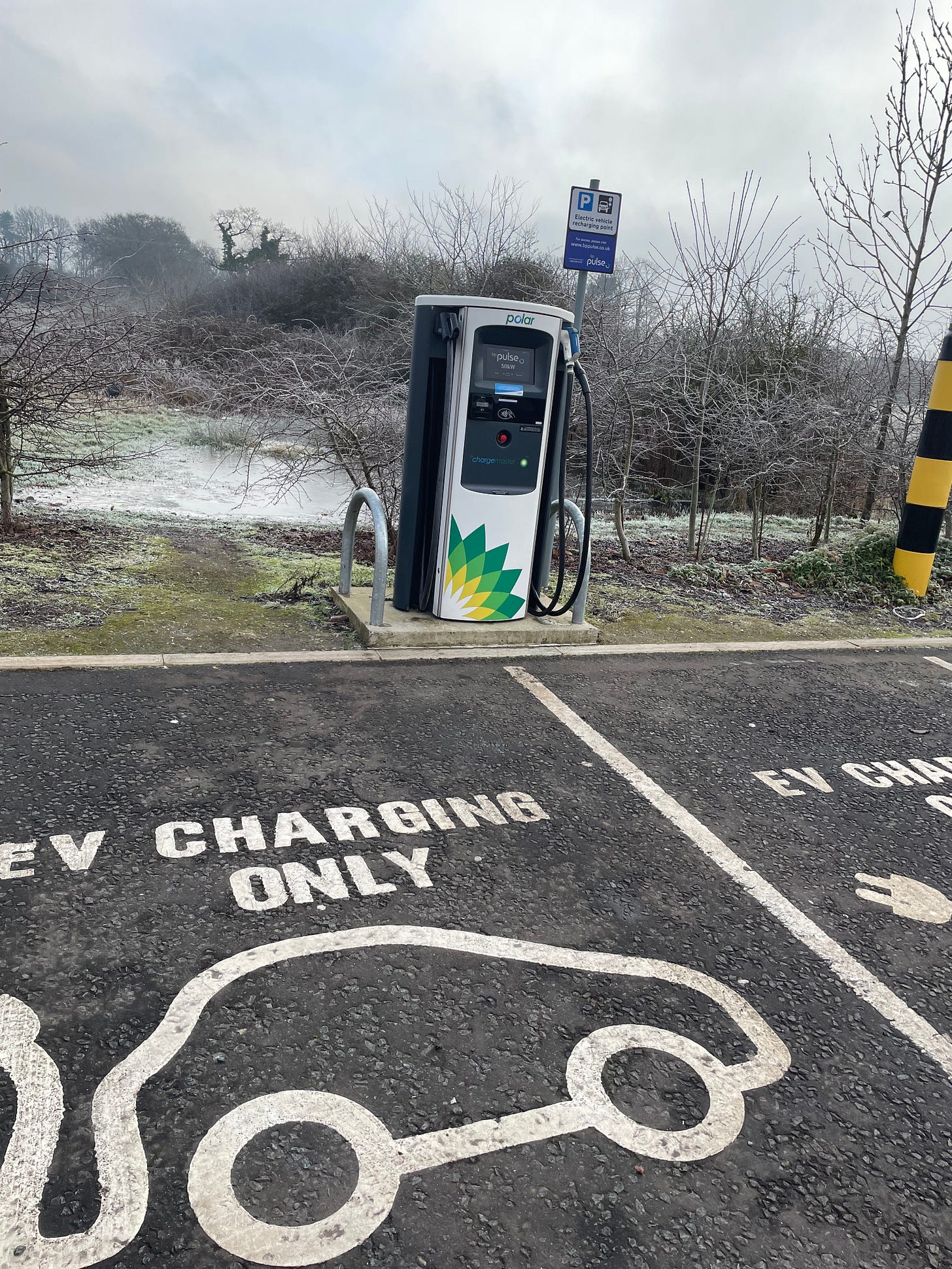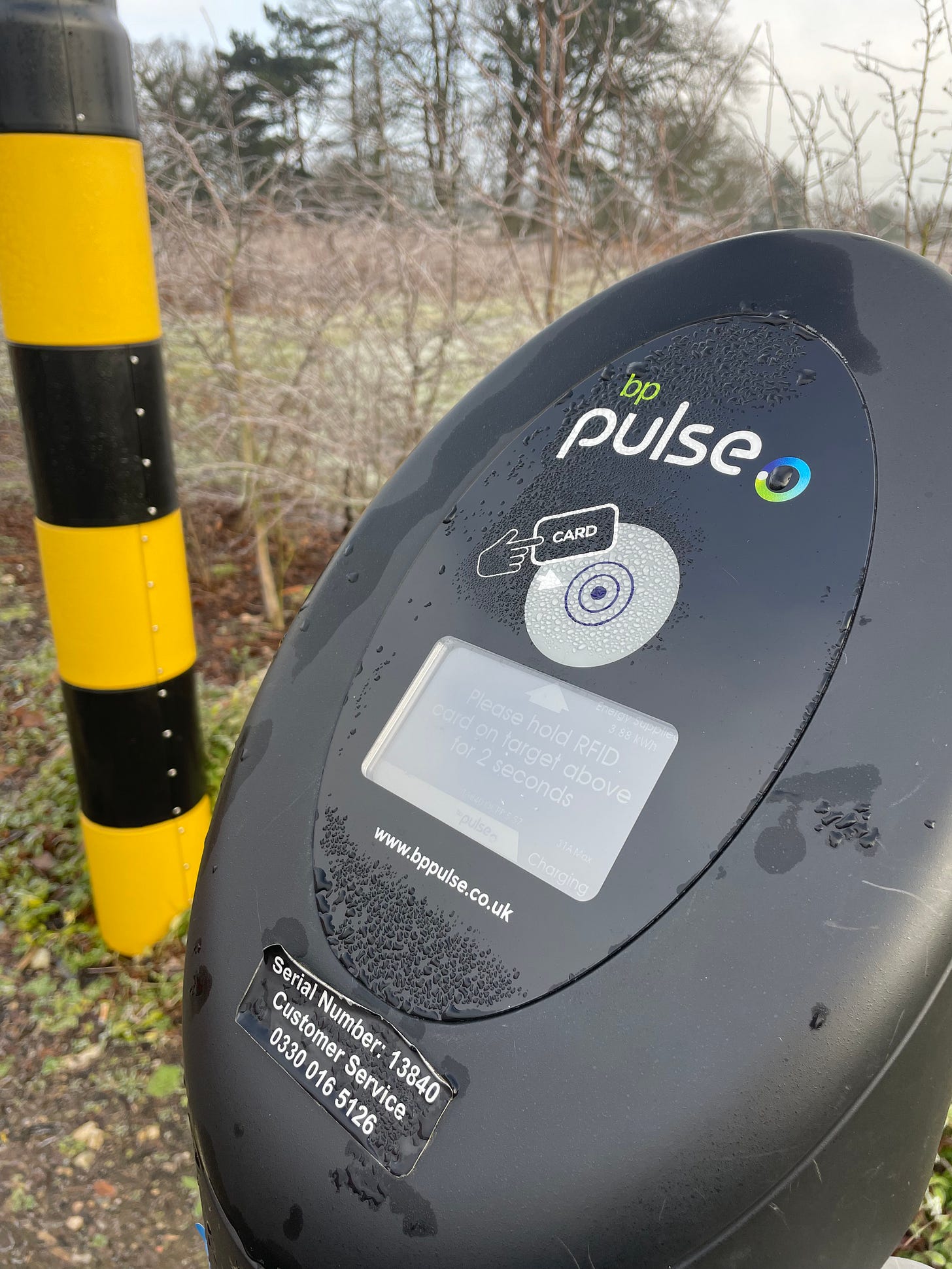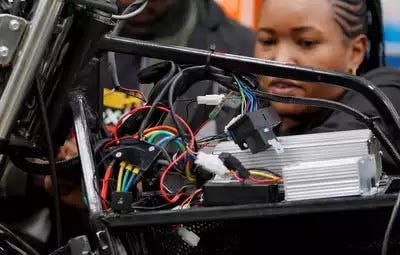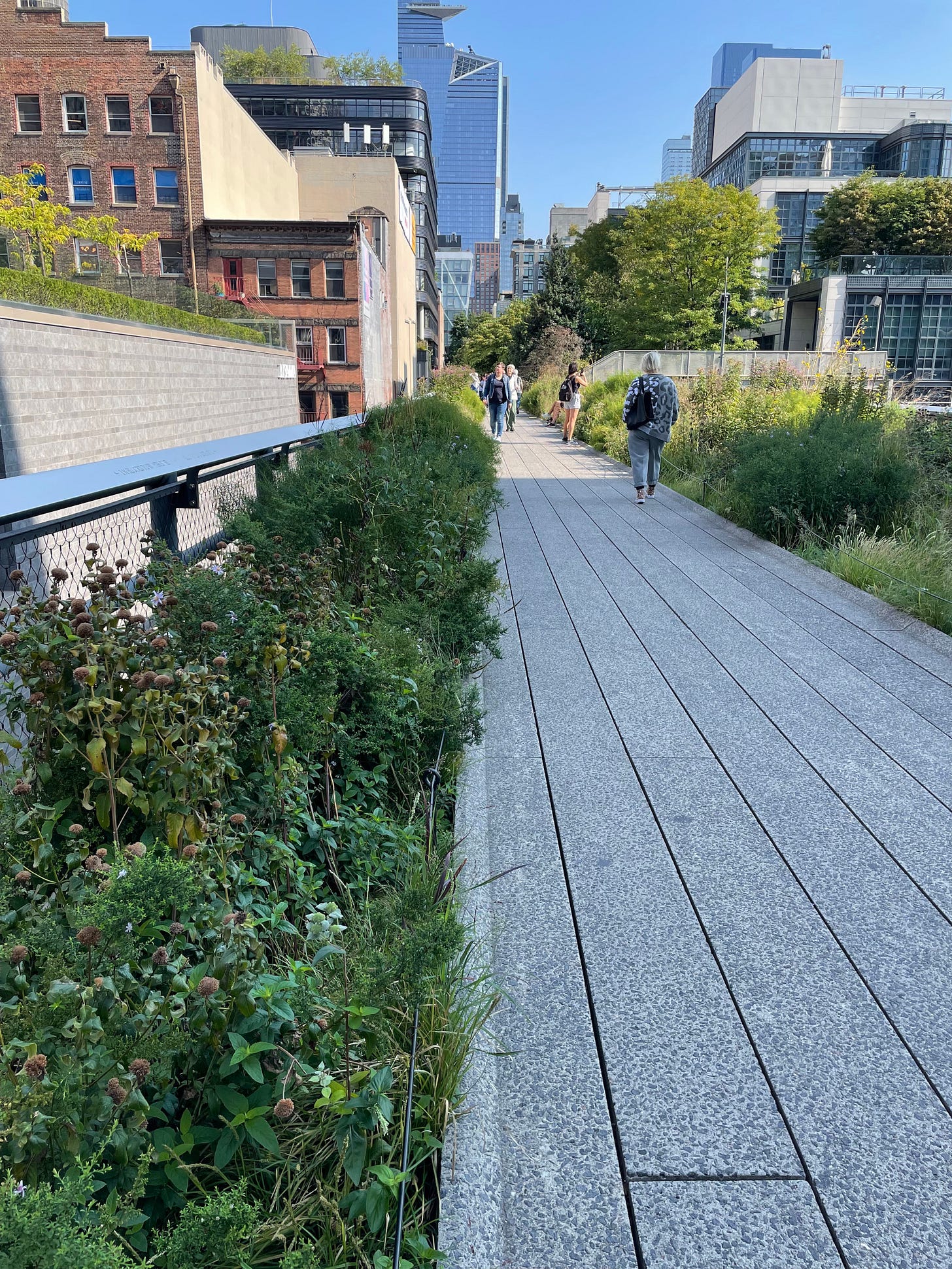Dumb Doubletree, typical BP, battery swap and new High Line
A collection of climate stories mostly
Brands behaving badly
Doubletree Hilton Chester and BP Pulse
I had the pleasure of staying at the Doubletree Hilton, Chester on Friday night. A flying visit to see my son at college and a school reunion for me on the Saturday, 40 plus years on.
I’d stayed at this Hilton once before and remembered it had plenty of parking. I neatly forgot about investigating overnight charging until I drove through the gates on Friday afternoon. Perhaps I’d get lucky.
In the furthest corner there were three dalek-like aliens offering electrical refreshment. The big one in the first picture had two connections offering 50 kilowatt (kW) speeds. Quicker than necessary for an overnight drip and a rather lumpy price of 69 pence per kW. A handsome parking charge.
A typical Tesla supercharger offers 150kW fast charging by comparison, and cost less, even when sited at service stations, notoriously expensive for fossil fuel.
Another guest was already connected, although they appeared to be finished. I hope the threat of an additional £10 fee per hour after 90 minutes of charging, was applied in full and the selfish guest received an unexpected £200 bill the next day. The vehicle was still there, frost bitten and connected, many hours later, when I returned from a late supper with Fin and friends.
The other two units didn’t accept credit cards. Instead, I needed to download the BP Pulse app or use their live map on the web to start paying for a charge.
Why make it so difficult to access BP? If I want befuddlement and a 20-minute hoop jumping exercise to gain access, I’ll go back to France. They are past masters at devising complex parking payment systems.
The other charger, less than 15 feet away, in use, but not in use, has normal contactless payment to conveniently overcharge me with the minimum of fuss. Which is also why Doubletree are in this weeks’ hall of shame.
They should be restraining themselves from making too big a profit from car park charging. Take a tip from the Aldi supermarket in Chester and subsidise BP’s commercial rate per kW, making it free for their customers to use.
I estimate the Doubletree car park holds between 300-400 cars. Their current charging facility is completely inadequate even though they have the space to comfortably put in a bank of 10 superchargers.
The city of Chester is also well underserved at the moment. This car park could become a significant source of additional revenue on the outskirts of the city, if properly equipped. More EV drivers would book overnight as a result, plus all the ad hoc meals, drinks and spa sessions for those who don’t want to sit in their cars.
Green discovery
Battery as a service in Nairobi
Courtesy of The Times of India
A motorbike battery swapping service is piloting in Nairobi, the capital of Kenya. Aside from forecasted growth into neighbouring Uganda and Tanzania, I wonder if this has promise for other capitals of the world?
One reason why electric motorbikes may well work there, is because 95% of Kenya’s consistent power supply is renewable, thanks to their hydroelectric and geothermal sources.
Installed geothermal capture is currently producing 836 megawatt (MW) with an estimated potential of 10,000MW in the future.
To provide a sense of scale; 600 MW would be the typical electricity generated from a coal-fired power station. (1000MW equals one gigawatt (GW) for completeness).
For a long time now, motorbikes have been popular in this biggest economy in East Africa. They’ve proven to be cheaper and quicker to get around than cars, but are also estimated to be 10 times as polluting.
Kenya has one million motorcyclists, most of which use their bikes to make a living as taxis and courier services.
Being able to instantly swap your bikes battery for a fully charged replacement at one of the many battery stations springing up in Nairobi, could save them time and money.
Ecobodaa, one of several start-ups has 50 electric motorbikes on the road and plans to have 1,000 by the end of the year. They sell an electric model for $1,500, about the same price as a fossil fuel motorbike. The price is comparable because the battery isn’t included. It’s the most expensive part of the motorbike, accounting for nearly 50% of the cost.
Instead the battery is rented to the biker for 300 Kenyan Shillings per day. The equivalent cost of daily fuel is between 700-800 Shillings, which is making the new scheme cost effective.
ARC Ride, another electric motorcycle start-up, is installing 200 swapping stations in Nairobi as well as expanding to Dar es Salaam and Kampala.
Why not extend this to electric cars everywhere?
Be happy
Planning approval for London’s new ‘Garden in the Sky’
New York’s High Line
One of the most enjoyable experiences on my trip last year to New York with Mrs H. was visiting the High Line, a stretch of deserted railway track, elevated on Manhattan’s West Side. It was saved from demolition by the neighbourhoods living either side of the tracks and opened as a park in 2009.
It appears that something very similar now has partial planning permission in London. It’s another disused railway line between Camden Town and King’s Cross. The intention being to create another green artery, designed and managed by the same architects responsible for New York’s High Line.
Courtesy of James Corner Field Operations
The total length of track between Camden Town and Kings Cross is 1.2km, although planning permission has only been granted for an initial section between Camden Gardens and Royal College Street. This is expected to open in 2025, but only if £14m can be raised to pay for its development.
The London Wildlife Trust’s ecological assessment in 2021 concluded that a wildlife corridor could be created, but the current sycamore and buddleia scrub would need to be extended to include many more varieties.
The plan is to plant a lot of trees which would include oak, maple, hazel, alder and ash. Apart from young woodlands there would be meadows and hedgerows as well as market gardens growing apples, pears and a range of vegetables including asparagus, peppers, squash and corn.
Local school visits will be encouraged with an outdoor nature classroom and eventually visitors walking the High Line will be able to enjoy a four mile circular walk as connections are made with existing green trails and parks.










Have you seen this https://m.youtube.com/watch?v=-5BPL4Nm1q0